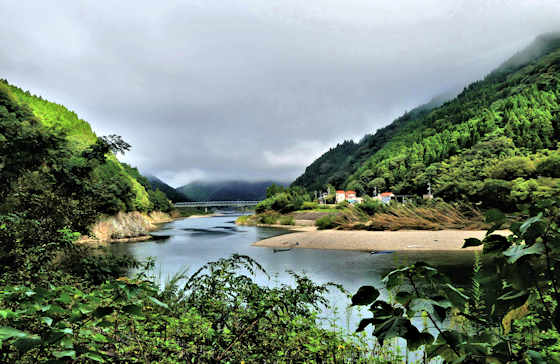I begin the second leg of my walk up the Gonokawa River to its source from my home. I live on the other bank to the one I am walking up. My plan is to later walk down the river from the source to the sea on this other bank. Looking across the river you can see a section of the river that has no road on that bank, hence my reason for starting this leg here, rather than
Kawahira where I finished the first leg.
Behind me is my village.
Across from my village is where te Yato River enters the Gonokawa. This is a decent-sized tributary with a dam and reservoir and it starts up in the mountains around the ski resorts of Mizuho. The bridge carries the now
closed rail line, the Sanko sen that used to follow the river all the way up to Miyoshi in Hiroshima.
The bridge that crosses the river to Kawado is painted in a very distinctive colour scheme that , I believe, represents the river, the sjy, and cherry blossoms. Not sure when the bridge was built. There was a major flood of Kawado back in the 1960's so it certainly postdates that. I have seen an old photos of a low wooden bridge in the 1920's, but for most of history the on,y wa to cross was by ferry.
Now protected, somewhat, by a high embankment, Kawado used to be the main town of the area. The large building is a traditional soy sauce brewery.
On top of the cliff at the first bend in the river is the Kawado suijin Onusa. This is the biggest one in the area and the main focus of the local Suijin Matsuri.
Looking upstream, that house is the only habitation in the several kilometers between Kawado and Tazu.
Kawabune, a generic term for riverboats. Traditionally made of wood, aluminum, and fibreglass are now more common, as are small outboard motors. I am guessing they are primarily used for fishing for Ayu, sweetfish, similar to trout. Larger, flat-bottomed boats were used for freight.
Looking back downstream to the Kawado Bridge. This next section of the road has no buildings and very little traffic, the main road being on the opposite bank, as it is for most of the river. The rail line is overgrown.























Thank you for this lovely post. It's neat to see your village. It's certainly located in a beautiful region!
ReplyDeleteYour village is very picturesque. I'd be interested to see more photos, especially during winter - though you may have plenty already and I've missed them. Speaking of railway lines, it'd be fascinating to follow exploration of some other live services to small and tucked away villages, along lesser known lines. Small country trains have a lot of charm. Do you have anything like that, either published or on the list to release?
ReplyDeleteAlways good to read your articles Jake, takes me away from the place I'm in right now.
The only other train line I think Ive written about on this site is thos one near us... https://www.ojisanjake.com/2020/11/okuizumo-orochi-train.html
Deleteclick the "shimonohara" label at the bottom of the post..... a few of the posts still have photos
Delete